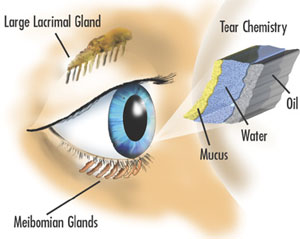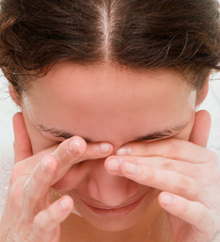Dry Eye is a very common, often chronic, condition in which there are insufficient tears to lubricate and nourish the eye. Most people with dry eyes either do not produce enough tears or have tears that evaporate too quickly. Others have poor quality tears.
Tears are produced by several glands which are located under  the upper eyelids. With each blink, tears are spread across the front surface of the eye. Tears reduce the risk of eye infection, wash away foreign matter in the eye, and keep the surface of the eyes smooth and the vision clear. Excess tears in the eyes flow into small drainage ducts in the inner corners of the eyelids which drain into the back of the nose.
the upper eyelids. With each blink, tears are spread across the front surface of the eye. Tears reduce the risk of eye infection, wash away foreign matter in the eye, and keep the surface of the eyes smooth and the vision clear. Excess tears in the eyes flow into small drainage ducts in the inner corners of the eyelids which drain into the back of the nose.
•Inadequate Amount of Tears—Tear production diminishes with age, with various medical conditions, or as a side effect of certain medications. Wind and dry climates can also affect tear volume by increasing tear evaporation. When tear production decreases or tears evaporate too quickly from the eyes, symptoms of dry eye can develop.
•Poor Quality of Tears—Tears are made up of three layers: oil, water, and mucin. Each component serves a function in protecting and nourishing the front surface of the eye. The outermost layer is the oil layer and it helps to prevent evaporation of the water layer which makes up the bulk of the tear volume and contains various nutrients and substances. The innermost layer is the mucin layer which functions in spreading the tears evenly over the surface of the eye. Deficiencies in any of the three layers can cause dry eye symptoms to develop.
SYMPTOMS OF DRY EYE People with dry eyes may experience the following:
People with dry eyes may experience the following:
- Stinging, burning, itchy/scratchy sensation
- Sensation of “having something in the eyes”
- Mucus discharge
- Increased irritation by smoke, wind, cold
- Eye fatigue
- Light sensitivity
- Redness
- Increasing contact lens discomfort or intolerance
- Excess watering of the eyes
- Blurry vision especially in the morning, at the end of the day, or in front of the computer
CAUSES OF DRY EYE
-
Age—Dry eye is a part of the natural aging process. The majority of people over age 65 experience some symptoms of dry eyes.
-
Gender—Women are more likely to develop dry eyes due to hormonal changes caused by pregnancy, the use of oral contraceptives, and menopause.
-
Medications—Certain medications, including antihistamines, decongestants, blood pressure medications, and antidepressants can reduce the amount of tears produced in the eyes.
-
Medical Conditions—People with Rheumatoid Arthritis, Diabetes, Parkinson's, and Thyroid problems are more likely to have symptoms of dry eyes. Also, inflammation of the surface of the eyes or eyelids (Blepharitis) and conditions that alter the position and structure of the lids can contribute to dry eyes.
-
Environmental Conditions—Exposure to smoke, wind, and dry climates can increase tear evaporation resulting in dry eye symptoms. Failure to blink regularly, such as when staring at a computer screen for long periods of time, can also contribute to drying of the eyes.
-
Other Factors—Long term use of contact lenses can be a factor in the development of dry eyes. Refractive eye surgery, such as LASIK, can cause decreased tear production and dry eyes.
TREATMENT OF DRY EYE
T reatments for dry eyes aim to restore or maintain the normal amount of tears in the eyes and/or to improve the quality of the tears. The primary approaches used to manage dry eyes are:
reatments for dry eyes aim to restore or maintain the normal amount of tears in the eyes and/or to improve the quality of the tears. The primary approaches used to manage dry eyes are:
-
Adding Tears—Mild cases of dry eyes can often be managed using over-the-counter artificial tear drops (e.g. Refresh Tears, Blink Tears, Theratears, Systane). These can be used as often as needed to supplement natural tear production. Preservative-free artificial tear solutions are recommended because they contain fewer additives that could further irritate the eyes.
-
Conserving Tears—An additional approach to reducing the symptoms of dry eyes is to keep the natural tears in the eyes longer. This can be done by occluding the tear ducts through which the tears normally drain. The tear ducts can be blocked with tiny silicone or gel-like plugs that can be removed, if needed. A surgical procedure to permanently close tear ducts can also be used. In either case, the goal is to keep the tears in the eye longer to reduce dry eye symptoms.
-
Increasing Tear Production—Prescription eye drops that help to increase the production of tears (Restasis), as well as taking Omega-3 fatty acid nutritional supplements are additional approaches to treating dry eyes.
-
Treating Any Contributing Eye Lid or Eye Surface Inflammation—Prescription medicated eye drops or ointments, warm compresses and lid massage, or eyelid cleaners (e.g. Sterilid, Ocusoft Lid Scrubs) may be recommended to help decrease inflammation of the lids and the surface of the eyes.
SELF CARE FOR DRY EYE
Steps you can take to reduce symptoms of dry eyes include:
-
Remember to blink regularly when reading or staring at a computer screen for long periods of time. Rule of thumb is “20-20-20”. Every 20 minutes for 20 seconds look at something 20 feet away or further. Positioning the computer screen so that it is slightly below eye level also helps to promote blinking and reduce eyestrain.
-
Use a humidifier at work and at home to add moisture to dry environments. Try to keep space heaters, air conditioners, and fans from blowing forced air directly at you.
-
Wear sunglasses outdoors, particularly those with a wrap around frame design to reduce exposure to drying winds and sun.
-
Use of nutritional supplements containing essential fatty acids (omega 3) may help decrease dry eye symptoms in some people.Avoid becoming dehydrated by drinking plenty of water each day.
-
Discontinue smoking which is a known eye irritant.
ALLERGIES AND DRY EYE
Allergies, whether they are seasonal or chronic, contribute to and can worsen dry eye symptoms. In addition, dry eyes can exacerbate allergy symptoms in the eye. Our tears are made up of primarily water and various other substances such as enzymes and proteins. People with allergies tend to have a higher concentration of these substances and a lower concentration of water in their tears. Over the counter antihistamines and medications for allergies tend to reduce the amount of water in the tears even more. The higher concentration of these enzymes and proteins in the tear film will cause the itching and irritation we often experience with allergies and because there is less water in the tears, our eyes will also feel dry. That is why allergies and dry eyes often occur together.
Part of the treatment regime for dry eyes often includes addressing any allergies a person may have. There are prescription (e.g. Pataday or Patanol) and over the counter antihistamine drops (e.g. Zatidor or Alaway) that help to reduce the symptoms of eye allergies. Artificial tear drops (preferably non preserved ones) will help restore the water component of the tears and dilute out some of the substances that cause the itching and irritation. The goal is the restore the balance between the water and the normal substances which make up our tear film.
Recommended Link
All About Vision: Dry Eye Syndrome

